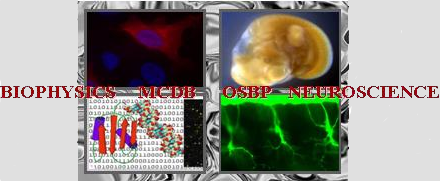Talk abstracts
Talk on Wednesday 09:30-09:45am submitted by Electra Coffman
Arvcf recruits Ankyrin-B and stabilizes the Cadherin-Catenin complex in the functional Aging Lens
Electra Coffman (Molecular, Cellular, and Developmental Biology Graduate Program), Jessica Martin (The Ohio State University, College of Optometry), Tiffani Thalacker (The Ohio State University, College of Optometry), Kenneth Herman (The Ohio State University, College of Optometry), Timothy F. Plageman Jr. (The Ohio State University, College of Optometry)
Abstract:
The eye lens is a unique transparent tissue responsible for focusing light onto the retina to produce a clear image. However, disruptions in lens cell structure can lead to cataracts, a disease marked by lens opacification. Although age is the highest global risk factor for cataract development, how cell architectural changes may contribute to its progression remains poorly characterized. We previously established that mice lacking a cell adhesion gene, Arvcf, develop disrupted adherens junctions (AJs) as soon as 1 month with premature cortical cataracts by 5 months of age. In a proteomic screening of mouse lens tissue, AJ protein N-Cadherin associates with cytoskeletal protein Ankyrin-B (AnkB). As mouse lenses lacking AnkB also possess cell adhesive disruptions, we hypothesize that Arvcf and AnkB function in a similar pathway to maintain lens fiber cell N-Cadherin and lens transparency over age. To test this, mouse lenses lacking one or both Arvcf or AnkB alleles were compared to a wild type control. Arvcf+/-; AnkB+/- mice were also produced to analyze synergistic effects. Lens lysates were analyzed by fractionation, immunoprecipitation, western blot, and/ or mass spectroscopy. This revealed that N-cadherin associates with both Arvcf and AnkB. Gene ontology analysis further identified novel Arvcf associations with neuronal and vesicular cellular components. Western blot reveals that the loss of Arvcf induces a dramatic decrease in N-Cadherin as well as its catenin binding partners. In-vitro and in-vivo immunofluorescent methods further reveal that Arvcf facilitates the recruitment of N-Cadherin and Ankyrin-B to the membrane. Immunofluorescent staining indicates that N-cadherin and AnkB may be reduced in the absence of Arvcf as early as one month. Lastly, fresh lenses were imaged with a stereomicroscope and analyzed with histological immunofluorescent staining followed by confocal microscopy. By 7 months of age, AnkB+/- or Arvcf+/-; AnkB+/- mouse lenses do not develop cataracts. Together, these data suggest that Arvcf may function in part to facilitate the association of Ankyrin-B to the cadherin-catenin complex. These findings further suggest a shared role for Arvcf and AnkB in stabilizing lens fiber AJs and architecture which may provide clues into future cortical cataract prevention.
Keywords: Cytoskeleton, Adherens junction, Cataract
